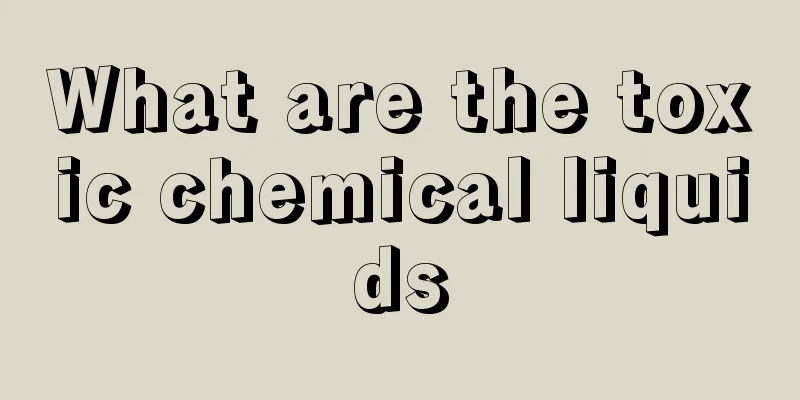What are the toxic chemical liquids

|
In our daily lives, if we come into contact with liquids that we are not familiar with, we must pay attention to whether they are toxic and try to avoid them. But what are the toxic chemical liquids? Ammonia is a very common liquid in our daily life. It is a toxic liquid. Sulfuric acid, hydrochloric acid, sodium hydroxide and potassium oxynitride are also toxic. If they accidentally get on the skin, they will be corrosive. 1. What are the toxic chemical liquids? Nitric acid, sulfuric acid, hydrochloric acid, sodium hydroxide, potassium nitrogen oxide, ammonia water, etc. are all irritating to the skin, are corrosive, and can cause chemical burns. Inhalation of strong acid fumes can irritate the respiratory tract, so be extra careful when using it. 2. What are the toxic gases? Bromine, chlorine, fluorine, hydrocyanic acid, hydrogen fluoride, hydrogen bromide, hydrogen chloride, sulfur dioxide, hydrogen sulfide, phosgene, ammonia, carbon monoxide, etc. are all asphyxiating irritating gases. When using the above gases or conducting experiments that produce the above gases, they must be carried out in a well-ventilated fume hood and a gas absorption device must be installed to absorb toxic gases and reduce environmental pollution. 3. What are the toxic inorganic chemicals? 1. Cyanide and hydrogen cyanide acid are extremely toxic and can cause poisoning very quickly. If the hydrogen cyanide content in the air reaches 0.03%, it can cause death within minutes. 2. Mercury can evaporate at room temperature and is extremely toxic, which can cause acute or chronic poisoning. When using, it must be done in a fume hood and pay attention to indoor ventilation. If it is accidentally spilled, use a water pump to collect it as completely as possible. 3. Bromine. Liquid bromine can cause skin burns, and its vapor can irritate mucous membranes and even cause blindness. It must be used in a fume hood. Glass bottles containing bromine must be tightly sealed and placed in a metal pile and properly stored to avoid being knocked over or overturned. If accidentally spilled or broken, cover it with fine sand immediately; if skin burns occur, rinse immediately with dilute ethanol or massage with plenty of glycerin, and then apply boric acid vaseline. 4. Metallic sodium and potassium will burn and explode when in contact with water, so be careful when using them. Sodium and potassium should be stored in kerosene or liquid paraffin, placed in an iron can, covered and placed in a dry place. It cannot be weighed on paper, but must be weighed in kerosene or liquid paraffin. 5. Yellow phosphorus is extremely toxic and must not be handled directly with your hands, otherwise it will cause severe and lasting burns. |
<<: What is the reason for growing white hair
>>: Early symptoms of herpetic pharyngitis
Recommend
How to dry osmanthus
If you want to use osmanthus as medicine or make ...
The reason why I always feel hungry
The energy for human physiological activities com...
Will nasopharyngeal cancer cause disability? How to treat it?
Some people worry that nasopharyngeal cancer can ...
Can fur be dry cleaned
Fur is a kind of precious clothing. Various kinds...
What to eat for elderly people with lung cancer? Dietary suggestions for lung cancer patients
We all know that the mortality rate of lung cance...
What should we pay attention to when practicing yoga?
Yoga is an elegant sport, and practicing yoga can...
Bump on the back of the neck
Many people cause serious harm to their bodies in...
What should I do and eat when my eyes are inflamed?
Getting angry is a relatively common phenomenon. ...
What are the effects of dandelion and black buckwheat tea
The dandelion plant is very common in our daily l...
Blood vessels bulge and pimple after half a month of infusion
Infusion therapy is a common treatment method in ...
What kind of red wine should I drink before going to bed
It is very good to drink some red wine before goi...
What medicine should I take for thick white tongue coating
Our tongue coating can well reflect the health of...
How to treat spots caused by excessive liver fire?
Excessive liver fire may cause spots over time, s...
What to do if you have stomach acid pain? Eat more of this food
Gastric acid is the hydrochloric acid secreted by...
Ovarian cancer patients need to be alert to cancer recurrence after surgery
Aunt Zhang is 52 years old and is a skilled worke...









